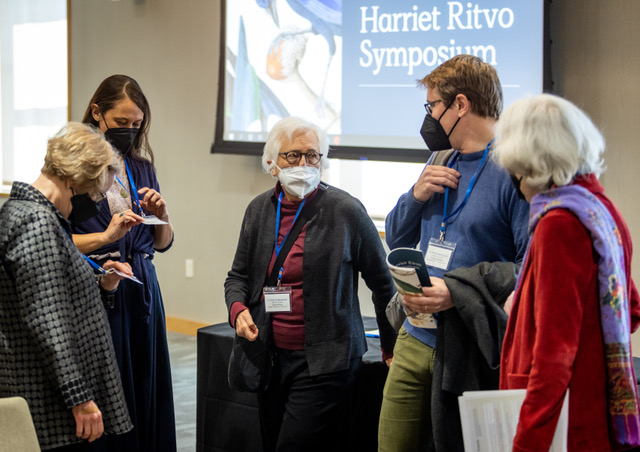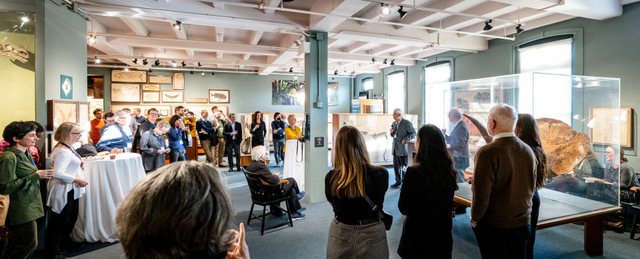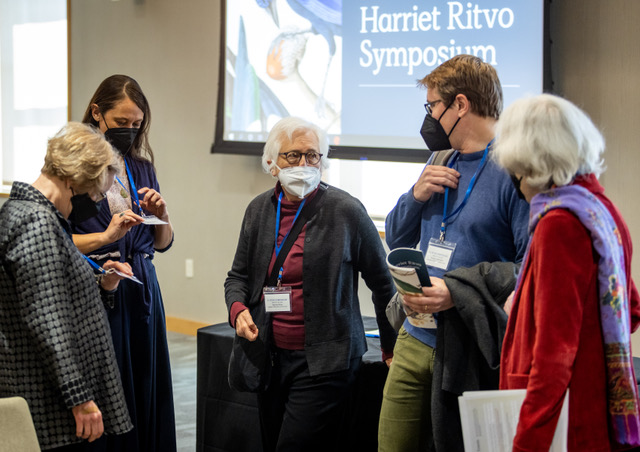
On Friday, April 29 and Saturday, April 30, MIT History hosted a two-day symposium at the Samberg Conference Center to celebrate the scholarly contributions of historian Harriet Ritvo, who retired from teaching in 2020 following a career spanning four decades at MIT. Organized by Ritvo’s former graduate advisees from the Doctoral Program in History, Anthropology and Science, Technology, and Society (HASTS), the event—which had been postponed for two years due to the pandemic—took the form of an academic conference featuring presentations by her past students on their current research projects. Each panel was arranged around specific themes outlined in Ritvo’s scholarship on the history of human-animal relationships, the history of science, and environmental history. The diversity of topics covered at the symposium were a fitting tribute to Ritvo’s own kaleidoscopic research interests, which have ranged from the history of British pet fanciers and zoological gardens to the politics of urban water infrastructure and mad cow disease.
Ritvo received her Ph.D. in English Literature from Harvard University in 1975 and joined the MIT Humanities Department in 1980. Her first book, The Animal Estate: The English and Other Creatures in the Victorian Age (1987)—a cultural history of livestock breeding, petkeeping, zoos, and big-game hunting in Britain and its colonies in the nineteenth century—helped to define the subfields of animal history and animal studies in the 1990s and early 2000s. Ritvo would also go on to make substantial contributions to the history of classification and taxonomy in natural history (The Platypus and the Mermaid, and Other Figments of the Classifying Imagination, 1997), and the history of environmentalism and industrial development (The Dawn of Green: Manchester, Thirlmere, and Modern Environmentalism, 2009). Noble Cows and Hybrid Zebras (2010) includes a selection of her articles. Over the course of her career, Ritvo has directed numerous doctoral dissertations at MIT, Harvard, and beyond. A commemorative tee-shirt printed for the symposium includes a timeline of her nearly forty graduate advisees since the early 1990s, alongside a corresponding photo-history of Ritvo’s beloved feline companions over the years (which have almost always been Siamese).
Former advisee Anya Zilberstein (HASTS ’08) opened the conference on Friday morning with the greeting “Welcome, animals!”—a reference to Ritvo’s popular MIT history course, “People and Other Animals.” The first session, “The Dawn of Green: Modern Ecologies and Environments,” featured presentations by Jessica Wang (HASTS ‘95) on the history of insect parasites as agents of biological control in early twentieth-century Hawaiian agriculture, Nicole Labruto (HASTS ’18) on current efforts by Brazilian molecular biologists to create genetically modified sugarcane varieties for biofuel production, and Barri Gold (Physics ‘88) on energy and ecology in the nineteenth-century novel.
Multispecies relations were a central theme of many of the presentations at the symposium. For the panel titled “The Animal Estate Across the Atlantic,” Whitney Barlow Robles (Harvard American Studies ’20) surveyed the cultural and scientific history of the raccoon in North America, charting the species’ transformation from a curious, “knowing beast” tamed and kept as pets by naturalists in the eighteenth and nineteenth centuries, to the modern “trash panda” that many urban and suburban dwellers regard as a nuisance. In a roundtable session on animal studies, Rebecca Woods (HASTS ’13) highlighted the importance of approaching archival materials creatively; she revealed how an interest in the emergence of international markets for refrigerated meat—a topic covered in the MIT dissertation that became her first book—led to her current project on the discovery of Siberian mammoths unearthed from the melting permafrost. Etienne Benson (HASTS ’08) presented on the use of digital sources in animal history, in which he humorously contemplated the reactions of future historians to the sheer volume of cat photos and videos posted online (a practice Ritvo herself is fond of engaging in). And in a session on “micropolitics” (a variation on Michel Foucault’s concept of “biopolitics”), Grace Kim-Butler (HASTS ’19) shared her ethnographic research on the attempts of monument restorationists to combat the growth of a resilient black “biofilm” on white marble, which is now thriving under the conditions brought about by climate change.
The first day concluded with an evening reception at the Harvard Museum of Natural History, where Ritvo has regularly brought students on field trips. After several toasts from colleagues, students, and friends, attendees were free to peruse the institution’s vast collection of taxidermy mounts, fossil displays, and glass flowers. The symposium reconvened the next morning for a half day of panel sessions, followed by Ritvo’s concluding remarks. In a brief speech, she thanked her students, above all, for having provided the most rewarding part of her career as a teacher, and noted her plans to continue collaborating with them.
As Professor Emeritus, Ritvo continues to advise graduate students in MIT’s HASTS Program and at Harvard. She is currently working on a book project on the history of wildness and domestication, tentatively titled The Edges of Wild.



